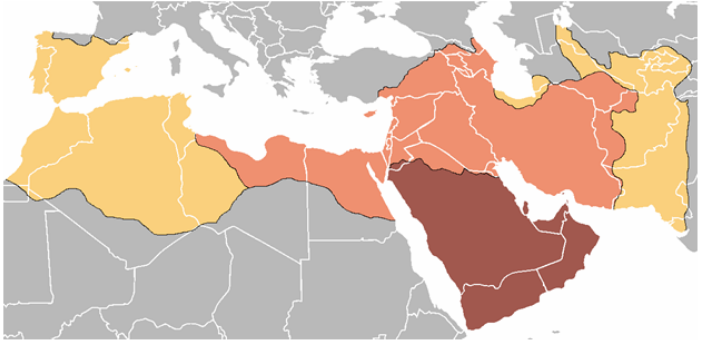7.4: Conquest in North Africa and Southwest Asia
- Page ID
- 21091
After Muhammad’s death, Arab military forces carried Islam across the region. At its greatest extent, the Islamic Empire under the Umayyad Caliphate of the 7th and 8th centuries stretched across 15 million square kilometers (5.79 million square miles), from the Iberian Peninsula, the southwest corner of Europe containing Spain and Portugal, all the way across North Africa and the Arabian Peninsula and into Pakistan (Figure \(\PageIndex{1}\)). No empire would be larger until the Mongols in the 13th century.

Figure \(\PageIndex{1}\): Map of the Islamic Empire under the Umayyad Caliphate Expansion, 622-
750 CE (Derivative work from original by Brian Szymanski, Wikimedia Commons, Public Domain)
The Islamic Empire continued for hundreds of years. Its capital moved from Medina to Damascus, the capital of modern-day Syria, and then to Baghdad, the capital of modern-day Iraq. By 1259 CE, however, much of this region, including Baghdad, was conquered by the Mongols, beginning a pattern of occupation and conquest that would continue until modern times.
The Ottoman Empire, based in modern-day Turkey, followed, taking control of much of North Africa and coastal Southwest Asia by the 15th and 16th centuries. Though it declined over time, the Ottomans maintained control of much of the region until it, along with the Central Powers of Germany, Austria-Hungary, and Bulgaria, lost World War I. Following World War I, the allied powers of Europe divided the former territory of the Ottoman Empire and carved out colonies.
The League of Nations, an intergovernmental organization which lasted from the end of World War I until the beginning of World War II, portioned the former Ottoman Empire and granted mandates for European powers to control parts of its territory. France, for example, was given a mandate for Syria. Britain was given a mandate to control Iraq as well as Palestine. The Italians, too, were able to take a piece of the Ottoman Empire, gaining control of Libya in the early 20th century.
As with many other parts of the world, the colonies of North Africa and Southwest Asia were formed with little attention to underlying ethnic tensions or resource issues. Some ethnic groups found themselves split amongst several different European colonies, while others were forced to share newly created territories with hostile groups. Even once colonies were able to get independence, these colonial-era issues would remain. Unevenly distributed oil wealth, which was not discovered in large quantities until after the withdraw of European powers, would further complicate political and economic stability in the region.


